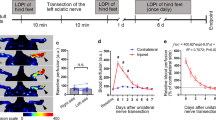Abstract
The aim of this experiment was to measure the concentration of neuropeptide Y (NPY), a vasoactive transmitter which coexists with noradrenaline in sympathetic nerve terminals, in venous blood taken from the painful and contralateral limbs of 16 patients with features of reflex sympathetic dystrophy (RSD) or causalgia. In nine patients tapping the skin of the affected limb provoked pain (allodynia). In seven of the nine patients with allodynia the concentration of NPY was lower on the painful side; similar results were obtained in only two of seven patients without widespread allodynia. In addition, the concentration of NPY was generally lower in the painful limb if it was warmer than the contralateral limb. These findings suggest that a reduction in sympathetic activity might accompany allodynia and influence vasomotor disturbances in patients with causalgic pain.
Similar content being viewed by others
References
Janig W, Blumberg H, Boas RA, Campbell JN. The reflex sympathetic dystrophy syndrome: consensus statement and general recommendations for diagnosis and clinical research. In: Bond MR, Charlton JE, Woolf CJ, eds.Proceedings of the Vlth World Congress on Pain. Amsterdam: Elsevier, 1991: 373–376.
International Association for the Study of Pain Subcommittee on Taxonomy. Classification of chronic pain: descriptions of chronic pain syndromes and definitions of pain terms.Pain 1986; (suppl 3): S28-S30.
Wallin G, Torebjork E, Hallin R. Preliminary observations on the pathophysiology of hyperalgesia in the causalgic pain syndrome. In: Zotterman Y, ed.Sensory Functions of the Skin in Primates, with Special Reference to Man. Wenner-Gren International Symposium, Volume 27. Oxford: Pergamon Press, 1976: 498–502.
Casale R, Elam M. Normal sympathetic nerve activity in a reflex sympathetic dystrophy with marked skin vasoconstriction.J Autonom Nerv Syst 1992;41: 215–220.
Christensen K, Henriksen O. The reflex sympathetic dystrophy syndrome. An experimental study of sympathetic reflex control of subcutaneous blood flow in the hand.Scand J Rheumatol 1983;12: 263–267.
Drummond PD, Finch PM, Smythe GA. Reflex sympathetic dystrophy: the significance of differing catecholamine concentrations in affected and unaffected limbs.Brain 1991;114: 2025–2036.
Harden RN. Norepinephrine levels in affected versus unaffected limb in sympathetically maintained pain.American Pain Society 10th Annual Scientific Meeting 1991: 37 (abstract).
Linton-Dahlof P. Modulatory interactions of neuropeptide Y (NPY) on sympathetic neurotransmission.Acta Physiol Scand 1989; (suppl 586): 1–85.
Goadsby PJ, Edvinsson L, Ekman R. Vasoactive peptide release in the extracerebral circulation of humans during migraine headache.Ann Neurol 1990;28: 183–187.
Edvinsson L, Ekman R, Thulin T. Circulating perivascular dilatory neuropeptides in hypertension.J Hypertension 1989;7 (suppl 7): S192-S193.
Ochoa JL. Reflex sympathetic dystrophy: a disease of medical misunderstanding.Clin J Pain 1992;8: 363–366.
Lundberg JM, Rudehill A, Sollevi A, Theodorsson-Norheim E, Hamberger B. Frequency- and reserpine-dependent chemical coding of sympathetic transmission: differential release of noradrenaline and neuropeptide Y from pig spleen.Neurosci Lett 1986;63: 96–100.
Pernow J, Lundberg JM, Kaijser L, Hjemdahl P. Theodorsson-Norheim E, Martinsson A, Pernow B. Plasma neuropeptide Ylike immunoreactivity and catecholamines during various degrees of sympathetic activation in man.Clin Physiol 1986;6: 561–578.
Aubert JF, Waeber B, Rossler B, Geering K, Nussberger J, Brunner HR. Effects of neuropeptide Y on the blood pressure response to various vasoconstrictor agonists.J Pharmacol Exp Ther 1988;246: 1088–1097.
Wahlestedt C, Hakanson R, Vas CA, Zukowska-Grojec Z. Norepinephrine and neuropeptide Y: vasoconstrictor cooperationin vivo andin vitro.Am J Physiol 1990;258: R736-R742.
Kahan T, Taddei S, Pedrinelli R, Hjemdahl P, Salvetti A. Nonadrenergic sympathetic vascular control of the human forearm in hypertension: possible involvement of neuropeptide Y.J Cardiovasc Pharmacol 1992;19: 587–592.
Hieble JP, Duesler JG, Daly RN. Effects of neuropeptide Y on the response of isolated blood vessels to norepinephrine and sympathetic field stimulation.J Pharmacol Exp Ther 1989;250: 523–528.
Giuliani S, Maggi CA, Meli A. Prejunctional modulatory action of neuropeptide Y on peripheral terminals of capsaicin-sensitive sensory nerves.Br J Pharmacol 1989;98: 407–412.
Grundemar L, Grundstrom N, Johansson IGM, Andersson RGG, Hakanson R. Suppression by neuropeptide Y of capsaicin-sensitive sensory nerve-mediated contraction in guinea-pig airways.Br J Pharmacol 1990;99: 473–476.
Cline MA, Ochoa J, Torebjork H. Chronic hyperalgesia and skin warming caused by sensitized C nociceptors.Brain 1989;112: 621–647.
LaMotte RH, Lundberg LER, Torebjork HE. Pain, hyperalgesia and activity in nociceptive C units in humans after intradermal injection of capsaicin.J Physiol 1992;448: 749–764.
Torebjork HE, Lundberg LER, LaMotte RH. Central changes in processing of mechanoreceptive input in capsaicin-induced secondary hyperalgesia in humans.J Physiol 1992;448: 765–780.
Roberts WJ. A hypothesis on the physiological basis for causalgia and related pains.Pain 1986;24: 297–311.
Meyer RA, Raja SN, Treede RD, Davis KD, Campbell JN. Neural mechanisms of sympathetically maintained pain. In: Janig W, Schmidt RF, eds.Reflex Sympathetic Dystrophy: Pathophysiological Mechanisms and Clinical lmplications. New York: VCH, 1992: 57–66.
Sato J, Perl ER. Adrenergic excitation of cutaneous pain receptors induced by peripheral nerve injury.Science 1991;251: 1608–1610.
Wakisaka S, Kajander KC, Bennett GJ. Increased neuropeptide Y (NPY)-like immunoreactivity in rat sensory neurons following peripheral axotomy.Neurosci Lett 1991;124: 200–203.
Frisen J, Risling M, Theodorsson E, Fried K. NPY-like immunoreactivity in sensory nerve fibres in rat sciatic neuroma.Brain Res 1992;577: 142–146.
Author information
Authors and Affiliations
Rights and permissions
About this article
Cite this article
Drummond, P.D., Finch, P.M., Edvinsson, L. et al. Plasma neuropeptide Y in the symptomatic limb of patients with causalgic pain. Clinical Autonomic Research 4, 113–116 (1994). https://doi.org/10.1007/BF01845774
Received:
Accepted:
Issue Date:
DOI: https://doi.org/10.1007/BF01845774




